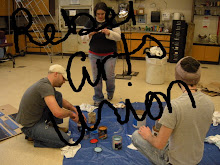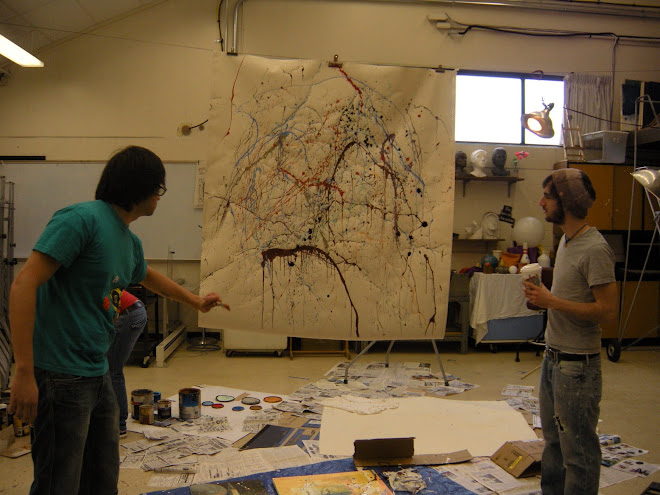Edges, Fractals and Doorways

Richard Taylor, associate professor of physics at Oregon University, has discovered a relationship between the "drip" paintings of Jackson Pollock and Benoit B. Mandlebrot's geometric fractals. Using a computer program the "repetitions of patterns at different magnifications" became apparent. Taylor went on to say:
Pollock wouldn't have known that fractals were out there, and he certainly wasn't a mathematician. He must have tuned into some natural process to create these.Taylor also inferred that his exploration into Pollock's fractal-like working method could help scientists to authenticate works of art.
From my work in making marks and images, there certainly is a point at which you arrive, a tuning-in to a natural process or a state of no-mind (mushin). You feel it much in the way that you know you are "in the zone", intention, action and energy unite. Previously undreamed of possibilities emerge. And yeah, it will be authentic in every sense. This transcendence in Pollock's work from the time of the "drip" paintings onwards has always bothered art historians. The aesthetic progression and development of this artist just didn't jive with the sudden greatness of his achievement. I believe that Jackson Pollock attained mushin (the no-mind, fractal-like zone) that has been the conduit of many of the arts, artifacts and disciplines I have discussed in Dear Charmides. These paintings were the byproduct of that experience. We have all experienced these moments, if only briefly.
Celtic culture abounds with quantum/chaos/fractal references. Several years back I thoroughly enjoyed reading Mary Pat Mann's article Doorways to Other Worlds, The Infinite Fractal Edges of Faery (Parabola, Fall 2003). In it she says:
Rational order is not a prominent feature in Celtic myth. Heroes and seers who deliberately sought out other worlds in quest of power, inspiration or both, inevitably found the strange and unpredictable. Those who returned told tales of beautiful people who never aged, but also of sheep that changed from black to white and back again by jumping over a fence, shouting birds, giant ants and wondrous beasts that twisted their bones within their skins and their skins over their bones. Among Celtic people today, the doorway to the between ordinary reality and these other lands are still ajar. At any time, ordinary people can find themselves, suddenly and without warning, in the presence of magic.She goes on to say:
Edges are rich environments...setting the stage for interactions and exchanges that happen nowhere else. In Celtic legend, the opening between this world and another is always an edge. These include the meeting of water and land, but also the hilltops (where earth and sky meet) or openings in the earth like caves (the boundary between above and below).
 There is in painting another stunning example of the magic of edges in the work of Johannes Vermeer. In his paintings Vermeer created each of the edges, or meetings between objects, surfaces, materials and people in a way which also taps into all of the comments above. He made an edge, not by drawing a boundary, but by approaching that meeting place from each side, in turn, with its own touch, its own sensations, its own level of focus, truly "setting the stage for interactions and exchanges that happen nowhere else."
There is in painting another stunning example of the magic of edges in the work of Johannes Vermeer. In his paintings Vermeer created each of the edges, or meetings between objects, surfaces, materials and people in a way which also taps into all of the comments above. He made an edge, not by drawing a boundary, but by approaching that meeting place from each side, in turn, with its own touch, its own sensations, its own level of focus, truly "setting the stage for interactions and exchanges that happen nowhere else."Mural On Indian Red Ground, 1950, Tehran Museum of Contemporary Art
Girl with a Red Hat, c. 1666-1667, National Gallery of Art, Washington, D.C.





